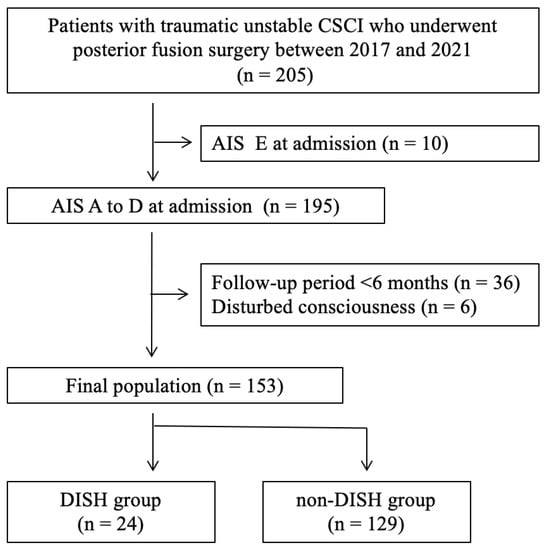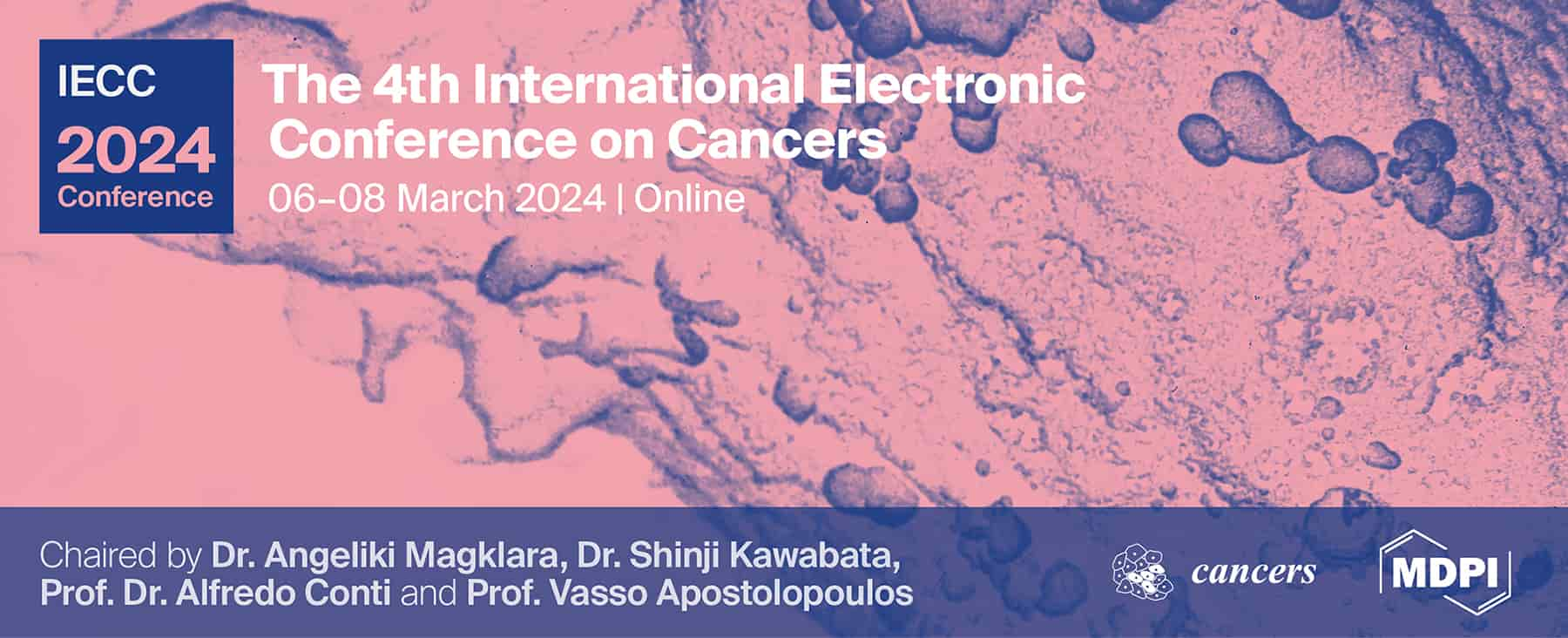-
 Endoscopic Transmural Therapy of Pancreatic Fistulas in an Interdisciplinary Setting—A Retrospective Data Analysis
Endoscopic Transmural Therapy of Pancreatic Fistulas in an Interdisciplinary Setting—A Retrospective Data Analysis -
 Histomorphometry of the Sural Nerve for Use as a CFNG in Facial Reanimation Procedures
Histomorphometry of the Sural Nerve for Use as a CFNG in Facial Reanimation Procedures -
 Ideal Cardiovascular Health and Risk of Cardiovascular Events or Mortality: A Systematic Review and Meta-Analysis of Prospective Studies
Ideal Cardiovascular Health and Risk of Cardiovascular Events or Mortality: A Systematic Review and Meta-Analysis of Prospective Studies -
 The Eight Unanswered and Answered Questions about the Use of Vasopressors in Septic Shock
The Eight Unanswered and Answered Questions about the Use of Vasopressors in Septic Shock -
 A JAK Inhibitor for Treatment of Rheumatoid Arthritis: The Baricitinib Experience
A JAK Inhibitor for Treatment of Rheumatoid Arthritis: The Baricitinib Experience
Journal Description
Journal of Clinical Medicine
Journal of Clinical Medicine
is an international, peer-reviewed, open access journal of clinical medicine, published semimonthly online by MDPI. The International Bone Research Association (IBRA), Italian Resuscitation Council (IRC), Spanish Society of Hematology and Hemotherapy (SEHH), Japan Association for Clinical Engineers (JACE), European Independent Foundation in Angiology/ Vascular Medicine (VAS) and others are all affiliated with JCM, and their members receive a discount on article processing charges.
- Open Access— free for readers, with article processing charges (APC) paid by authors or their institutions.
- High Visibility: indexed within Scopus, SCIE (Web of Science), PubMed, PMC, Embase, CAPlus / SciFinder, and other databases.
- Journal Rank: JCR - Q2 (Medicine, General & Internal) / CiteScore - Q1 (General Medicine)
- Rapid Publication: manuscripts are peer-reviewed and a first decision is provided to authors approximately 19.7 days after submission; acceptance to publication is undertaken in 2.7 days (median values for papers published in this journal in the first half of 2023).
- Recognition of Reviewers: reviewers who provide timely, thorough peer-review reports receive vouchers entitling them to a discount on the APC of their next publication in any MDPI journal, in appreciation of the work done.
- Companion journals for JCM include: Epidemiologia, Transplantology, Uro, Sinusitis, Rheumato, Biologics, Journal of Clinical & Translational Ophthalmology, Journal of Vascular Diseases and Osteology.
Impact Factor:
3.9 (2022);
5-Year Impact Factor:
4.1 (2022)
Latest Articles
The Impact of Diffuse Idiopathic Skeletal Hyperostosis on Nutritional Status, Neurological Outcome, and Perioperative Complications in Patients with Cervical Spinal Cord Injury
J. Clin. Med. 2023, 12(17), 5714; https://doi.org/10.3390/jcm12175714 (registering DOI) - 01 Sep 2023
Abstract
This retrospective study aimed to investigate the characteristics of patients with cervical spinal cord injuries (CSCI) with diffuse idiopathic skeletal hyperostosis (DISH). We included 153 consecutive patients with CSCI who underwent posterior decompression and fusion surgery. The patients were divided into two groups
[...] Read more.
This retrospective study aimed to investigate the characteristics of patients with cervical spinal cord injuries (CSCI) with diffuse idiopathic skeletal hyperostosis (DISH). We included 153 consecutive patients with CSCI who underwent posterior decompression and fusion surgery. The patients were divided into two groups based on the presence of DISH. Patient characteristics, neurological status on admission, nutritional status, perioperative laboratory variables, complications, neurological outcomes at discharge, and medical costs were compared between the groups. The DISH group (n = 24) had significantly older patients (72.1 vs. 65.9, p = 0.036), more patients with low-impact trauma (62.5% vs. 34.1%, p = 0.009), and a lower preoperative prognostic nutritional index on admission (39.8 vs. 42.5, p = 0.014) than the non-DISH group (n =129). Patients with DISH had significantly higher rates of ventilator management (16.7% vs. 3.1%, p = 0.022) and pneumonia (29.2% vs. 8.5%, p = 0.010). There was no significant difference in medical costs and neurological outcomes on discharge. Patients with CSCI and DISH were older, had poor nutritional status, and were prone to postoperative respiratory complications, while no differences were found between the neurological outcomes of patients with CSCI with and without DISH.
Full article
(This article belongs to the Special Issue Clinical Advances in Spinal Cord Injury)
►
Show Figures
Open AccessArticle
First-Generation iStent Bypass Implantation versus ab Externo Canaloplasty Combined with Phacoemulsification in Patients with Primary Open Angle Glaucoma—12-Month Follow-Up
J. Clin. Med. 2023, 12(17), 5711; https://doi.org/10.3390/jcm12175711 (registering DOI) - 01 Sep 2023
Abstract
This prospective, non-randomized, interventional clinical study evaluated the efficacy and safety profile of first-generation iStent bypass implantation versus ab externo canaloplasty, both combined with phacoemulsification, in patients with primary open-angle glaucoma (POAG) after 12-month follow-up. A total of 138 patients with POAG and
[...] Read more.
This prospective, non-randomized, interventional clinical study evaluated the efficacy and safety profile of first-generation iStent bypass implantation versus ab externo canaloplasty, both combined with phacoemulsification, in patients with primary open-angle glaucoma (POAG) after 12-month follow-up. A total of 138 patients with POAG and their 138 eyes (69 phaco-iStent and 69 phacocanaloplasty) were included. Postoperatively at 12 months, the mean intraocular pressure (IOP) decreased from 18.44 ± 3.88 to 15.51 ± 2.50 mmHg and from 17.20 ± 4.04 to 14.97 ± 2.37 mmHg in the phaco-iStent (PiS) and phacocanaloplasty (PC) groups, respectively (p = 0.480). In both groups, 35.7% achieved >20% IOP reduction from baseline. A total of 86% and 71.4% of the eyes were medication-free at 12 months in the PiS and PC groups, respectively. In both groups, all eyes showed improvement in best-corrected visual acuity compared with baseline and demonstrated similar safety profiles throughout the 12-month follow-up period. This study showed equal hypotensive effects of PiS and PC. Both procedures significantly reduced the IOP and the requirement for IOP-lowering medications for at least 12 months postoperatively, with no significant differences between the groups.
Full article
(This article belongs to the Section Ophthalmology)
►▼
Show Figures

Figure 1
Open AccessReview
Revisiting Diagnosis and Treatment of Hypertrophic Cardiomyopathy: Current Practice and Novel Perspectives
by
, , , , , , , , , , , and
J. Clin. Med. 2023, 12(17), 5710; https://doi.org/10.3390/jcm12175710 (registering DOI) - 01 Sep 2023
Abstract
Sarcomeric hypertrophic cardiomyopathy (HCM) is a prevalent genetic disorder characterised by left ventricular hypertrophy, myocardial disarray, and an increased risk of heart failure and sudden cardiac death. Despite advances in understanding its pathophysiology, treatment options for HCM remain limited. This narrative review aims
[...] Read more.
Sarcomeric hypertrophic cardiomyopathy (HCM) is a prevalent genetic disorder characterised by left ventricular hypertrophy, myocardial disarray, and an increased risk of heart failure and sudden cardiac death. Despite advances in understanding its pathophysiology, treatment options for HCM remain limited. This narrative review aims to provide a comprehensive overview of current clinical practice and explore emerging therapeutic strategies for sarcomeric HCM, with a focus on cardiac myosin inhibitors. We first discuss the conventional management of HCM, including lifestyle modifications, pharmacological therapies, and invasive interventions, emphasizing their limitations and challenges. Next, we highlight recent advances in molecular genetics and their potential applications in refining HCM diagnosis, risk stratification, and treatment. We delve into emerging therapies, such as gene editing, RNA-based therapies, targeted small molecules, and cardiac myosin modulators like mavacamten and aficamten, which hold promise in modulating the underlying molecular mechanisms of HCM. Mavacamten and aficamten, selective modulators of cardiac myosin, have demonstrated encouraging results in clinical trials by reducing left ventricular outflow tract obstruction and improving symptoms in patients with obstructive HCM. We discuss their mechanisms of action, clinical trial outcomes, and potential implications for the future of HCM management. Furthermore, we examine the role of precision medicine in HCM management, exploring how individualised treatment strategies, including exercise prescription as part of the management plan, may optimise patient outcomes. Finally, we underscore the importance of multidisciplinary care and patient-centred approaches to address the complex needs of HCM patients. This review also aims to encourage further research and collaboration in the field of HCM, promoting the development of novel and more effective therapeutic strategies, such as cardiac myosin modulators, to hopefully improve the quality of life and outcome of patients with sarcomeric HCM.
Full article
(This article belongs to the Special Issue Hypertrophic Cardiomyopathy—Current Challenges and Future Perspectives)
►▼
Show Figures
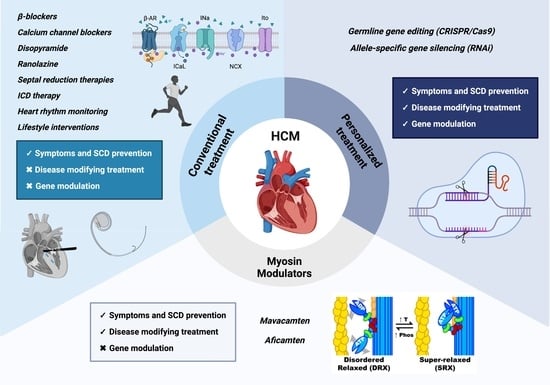
Graphical abstract
Open AccessEditorial
New Technologies in Endourology and Laser Lithotripsy: The Need for Evidence in Comprehensive Clinical Settings
by
, , , , , , , , , , , , , , , and
J. Clin. Med. 2023, 12(17), 5709; https://doi.org/10.3390/jcm12175709 (registering DOI) - 01 Sep 2023
Abstract
Flexible ureteroscopy (fURS) with laser lithotripsy is currently the gold standard surgical treatment for ureteral and kidney stones with a maximum diameter of 2 cm [...]
Full article
(This article belongs to the Section Nephrology & Urology)
Open AccessEditorial
Surgery and Reason: The End of History and the Last Surgeon
J. Clin. Med. 2023, 12(17), 5708; https://doi.org/10.3390/jcm12175708 (registering DOI) - 01 Sep 2023
Abstract
Arguably, Georg Wilhelm Friedrich Hegel has been one of the most influential philosophers of the 19th century [...]
Full article
(This article belongs to the Special Issue Clinical Outcomes Improvement and Perioperative Management of Surgical Patients)
►▼
Show Figures
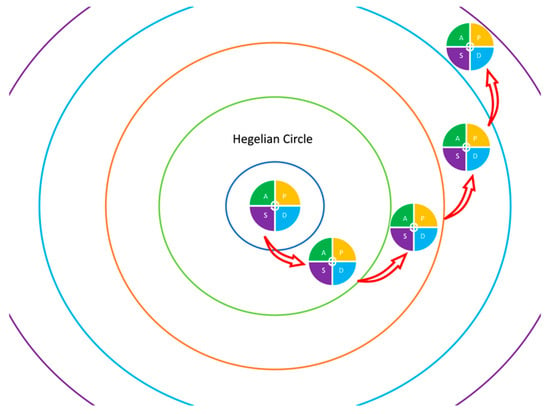
Figure 1
Open AccessFeature PaperArticle
Benefits of Premaquick® Combined Detection of IL-6/Total IGFBP-1/Native IGFBP-1 to Predict Preterm Delivery
by
, , , , , , , and
J. Clin. Med. 2023, 12(17), 5707; https://doi.org/10.3390/jcm12175707 (registering DOI) - 01 Sep 2023
Abstract
We conducted a prospective double-blind study to compare two vaginal diagnostic methods in singleton pregnancies with threatened preterm labor (TPL) at the University Hospital of Clermont-Ferrand (France) from August 2018 to December 2020. Our main objective was to compare the diagnostic capacity at
[...] Read more.
We conducted a prospective double-blind study to compare two vaginal diagnostic methods in singleton pregnancies with threatened preterm labor (TPL) at the University Hospital of Clermont-Ferrand (France) from August 2018 to December 2020. Our main objective was to compare the diagnostic capacity at admission, in terms of positive predictive value (PPV) and negative predictive value (NPV), of Premaquick® (combined detection of IL-6/total IGFBP-1/native IGFBP-1) and QuikCheck fFN™ (fetal fibronectin) for delivery within 7 days in cases of TPL. We included 193 patients. Premaquick® had a sensitivity close to 89%, equivalent to QuikCheck fFN™, but a higher statistical specificity of 49.5% against 38.6% for QuikCheck fFN™. We found no superiority of Premaquick® over QuickCheck fFN™ in terms of PPV (6.6% vs. 7.9%), with NPV being equivalent in predicting childbirth within 7 days in cases of TPL (98.6% vs. 98.9%). Nevertheless, the combination of positive native and total IGFBP-1 and the combination of all three positive markers were associated with a higher PPV. Our results, though non-significant, support this combined multiple-biomarker approach to improve testing in terms of predictive values.
Full article
(This article belongs to the Section Obstetrics & Gynecology)
►▼
Show Figures
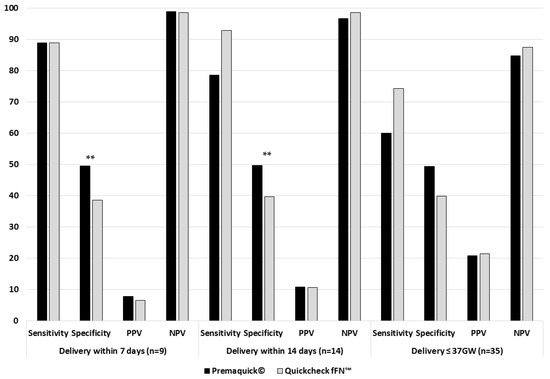
Figure 1
Open AccessArticle
Factors Associated with Refractive Prediction Error after Phacotrabeculectomy
J. Clin. Med. 2023, 12(17), 5706; https://doi.org/10.3390/jcm12175706 (registering DOI) - 01 Sep 2023
Abstract
Purpose: To compare refractive prediction errors between phacotrabeculectomy and phacoemulsification. Methods: Refractive prediction error was defined as the difference in spherical equivalent between the predicted value using the Barrett Universal II formula and the actual value obtained at postoperative one month. Forty-eight eyes
[...] Read more.
Purpose: To compare refractive prediction errors between phacotrabeculectomy and phacoemulsification. Methods: Refractive prediction error was defined as the difference in spherical equivalent between the predicted value using the Barrett Universal II formula and the actual value obtained at postoperative one month. Forty-eight eyes that had undergone phacotrabeculectomy (19 eyes, open-angle glaucoma; 29 eyes, angle-closure glaucoma) were matched with 48eyes that had undergone phacoemulsification by age, average keratometry value and axial length (AL), and their prediction errors were compared. The factors associated with prediction errors were analyzed by multivariable regression analyses. Results: The phacotrabeculectomy group showed a larger absolute prediction error than the phacoemulsification group (0.51 ± 0.37 Diopters vs. 0.38 ± 0.22 Diopters, p = 0.033). Larger absolute prediction error was associated with longer AL (p = 0.010) and higher intraocular pressure (IOP) difference (p = 0.012). Hyperopic shift (prediction error > 0) was associated with shallower preoperative anterior chamber depth (ACD) (p = 0.024) and larger IOP difference (p = 0.031). In the phacotrabeculectomy group, the prediction error was inversely correlated with AL: long eyes showed myopic shift and short eyes hyperopic shift (p = 0.002). Conclusions: Surgeons should be aware of the possibility of worse refractive outcomes when planning phacotrabeculectomy, especially in eyes with high preoperative IOP, shallow ACD, and/or extreme AL.
Full article
(This article belongs to the Special Issue Latest Advances in Glaucoma, Cataract and Refractive Surgery: Expert Views)
►▼
Show Figures

Figure 1
Open AccessEditorial
Epidemiology, Diagnosis, Treatment, and Prognosis of Infective Endocarditis
J. Clin. Med. 2023, 12(17), 5705; https://doi.org/10.3390/jcm12175705 (registering DOI) - 01 Sep 2023
Abstract
Infective endocarditis (IE) has experienced enormous changes in recent decades [...]
Full article
(This article belongs to the Special Issue Epidemiology, Diagnosis, Treatment, and Prognosis of Infective Endocarditis)
Open AccessArticle
Sex Differences in the Diagnosis, Management, and Outcomes of Suspected Non-ST-Elevation Acute Coronary Syndromes Meeting Rapid Rule-Out Criteria
J. Clin. Med. 2023, 12(17), 5704; https://doi.org/10.3390/jcm12175704 (registering DOI) - 01 Sep 2023
Abstract
(1) Background: patients who meet current rapid rule-out criteria for myocardial infarction (MI) are considered low risk, yet their management remains nebulous, especially among women. We aimed to examine sex differences in the diagnosis, management, and outcomes of patients meeting the rapid rule-out
[...] Read more.
(1) Background: patients who meet current rapid rule-out criteria for myocardial infarction (MI) are considered low risk, yet their management remains nebulous, especially among women. We aimed to examine sex differences in the diagnosis, management, and outcomes of patients meeting the rapid rule-out criteria. (2) Methods: by simulating application of the rapid rule-out MI criteria, we analyzed consecutively triaged men and women with suspected NSTE-ACS who had high-sensitivity cardiac troponin T (hs-cTnT) values that met criteria (n = 11,477), in particular, those who were admitted (n = 3775). (3) Results: men constituted ~55% of triaged patients who met the rule-out criteria, whether admitted or discharged. Men were more likely to be admitted (33.7% vs. 31.9%, p = 0.04), more commonly with hs-cTnT values between level of detection (LOD, 5 ng/ml) and the 99th percentile (59.4% of all admissions vs. 40.5% for women), whereas women were more likely to be admitted with values < level of blank (LOB, 3 ng/mL; 22.9% vs. 9.2% for men). Thirty-day mortality (1 man and 1 woman) and in-hospital MI (9 men vs. 1 woman) were uncommon among admitted patients, yet resource utilization during 3–4 hospitalization days was substantial for both sexes, with men undergoing coronary angiography (6.8% vs. 2.9%) and revascularization (3.4% vs. 1.1%) more commonly. Long-term survival for both men and women, whether admitted or discharged, was significantly worse for hs-cTnT values between LOD and the 99th percentile, even after adjusting for age and cardiovascular comorbidities. (4) Conclusions: reporting actual hs-cTnT values < 99th percentile allows for better risk stratification, especially for women, possibly closing the sex gap.
Full article
(This article belongs to the Special Issue Diagnosis, Monitoring, and Treatment of Myocardial Infarction)
►▼
Show Figures
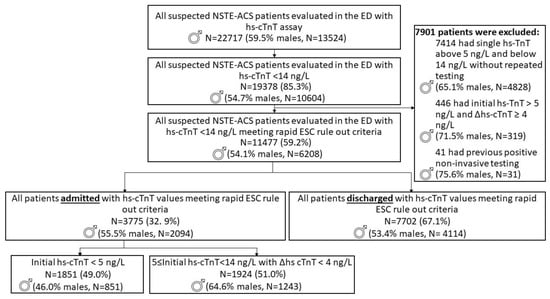
Figure 1
Open AccessFeature PaperArticle
The Natural History and Management of Hepatic Hemangioma
J. Clin. Med. 2023, 12(17), 5703; https://doi.org/10.3390/jcm12175703 (registering DOI) - 01 Sep 2023
Abstract
Background: Knowledge of the natural history and management of hepatic hemangiomas is lacking. The aim of this study was to investigate the natural history of hemangiomas and to elucidate the factors that determine tumor growth and optimal management. Methods: A total of 211
[...] Read more.
Background: Knowledge of the natural history and management of hepatic hemangiomas is lacking. The aim of this study was to investigate the natural history of hemangiomas and to elucidate the factors that determine tumor growth and optimal management. Methods: A total of 211 adult patients were enrolled, with follow-up for more than three years. Follow-up was performed with repeated ultrasonography (US) and laboratory tests for liver function and coagulation factors (platelets, prothrombin time (PT), fibrinogen, thrombin–antithrombin III complex (TAT), D-dimer, and fibrin and fibrinogen degradation products (FDP)). Results: Tumor size decreased in 38.9% of patients, showed no change in 31.3%, and increased in 29.8%. The incidence of a size increase was very high in patients under 40 years of age and decreased gradually with age, whereas the incidence of a size decrease increased with age and increased markedly over 60 years of age. The incidence of an increase in size decreased gradually with size enlargement, whereas the incidence of a decrease in size increased markedly with tumor size and further increased rapidly when hemangiomas became larger than 60 mm. Values of TAT, D-dimer, FDP, and Mac-2 binding protein glycosylation isomer (M2BPGi) were closely related to the change in size of hemangiomas. Conclusions: Hemangiomas in older patients (>60 years of age) and larger tumors (>60 mm in size) had a tendency to decrease in size, resulting from the reduction in coagulation disorders and the progression of liver fibrosis. Therefore, the majority of patients with hemangiomas can be safely managed by clinical observation.
Full article
(This article belongs to the Section Gastroenterology & Hepatopancreatobiliary Medicine)
►▼
Show Figures
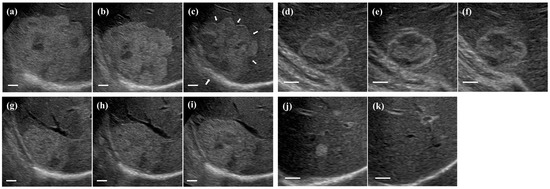
Figure 1
Open AccessReview
Primary Hemostasis Disorders as a Cause of Heavy Menstrual Bleeding in Women of Reproductive Age
by
, , , , and
J. Clin. Med. 2023, 12(17), 5702; https://doi.org/10.3390/jcm12175702 (registering DOI) - 01 Sep 2023
Abstract
Heavy menstrual bleeding (HMB) is a common clinical condition affecting adolescent and adult women and compromising their quality of life. Primary hemostasis disorders, affecting platelet plug formation, can be the underlying cause of HMB. They comprise a heterogeneous group of diseases with Von
[...] Read more.
Heavy menstrual bleeding (HMB) is a common clinical condition affecting adolescent and adult women and compromising their quality of life. Primary hemostasis disorders, affecting platelet plug formation, can be the underlying cause of HMB. They comprise a heterogeneous group of diseases with Von Willebrand disease (VWD) being the most commonly diagnosed; other disorders in this group that have been linked to HMB include (a) Glanzmann thrombasthenia, (b) Bernard–Soulier syndrome, (c) Hermansky–Pudlak syndrome, (d) immune thrombocytopenia (ITP), and (e) Ehlers–Danlos syndromes (EDS) and hypermobility spectrum disorders (HSD). Diagnosing these diseases can be challenging, as the basic laboratory investigations can be within the normal range. Thus, identification of specific clinical features and a thorough hematologic workup can be very important, providing the correct diagnosis. Proper diagnosis of the underlying disorder is important, as management may vary accordingly. Although disease-specific management guidelines exist for some of these disorders such as VWD and ITP, due to the rarity of most primary hemostasis disorders, the best approach for the management of HMB in these women remains elusive. The goal of this study was to create an informative, comprehensive review of the primary hemostasis disorders that have been linked to HMB. This study provides a summary of the basic published information regarding epidemiology, pathophysiology, clinical phenotype, diagnosis, and treatment of HMB in those diseases and serves as a reference guide for further reading.
Full article
(This article belongs to the Special Issue Gynecologic and Obstetric Pathologies: From Birth to Menopause)
►▼
Show Figures
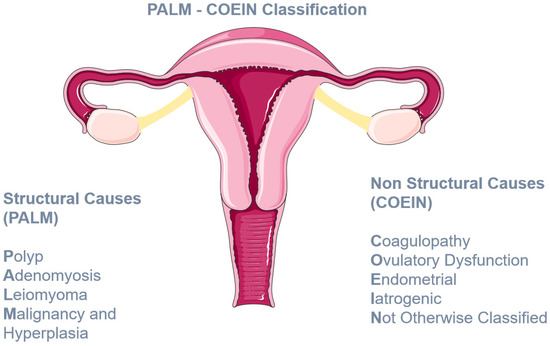
Figure 1
Open AccessArticle
Posterior Decompression and Fixation for Thoracic Spine Ossification: A 10-Year Follow-Up Study
by
, , , , , , , , , , , , , , and
J. Clin. Med. 2023, 12(17), 5701; https://doi.org/10.3390/jcm12175701 (registering DOI) - 01 Sep 2023
Abstract
Ossification of the posterior longitudinal ligament of the thoracic spine (T-OPLL) causes symptoms including leg and back pain, and motor and sensory deficits. This study retrospectively reviewed 32 patients who initially underwent posterior decompression with instrumented fusion (PDF) for T-OPLL between 2001 and
[...] Read more.
Ossification of the posterior longitudinal ligament of the thoracic spine (T-OPLL) causes symptoms including leg and back pain, and motor and sensory deficits. This study retrospectively reviewed 32 patients who initially underwent posterior decompression with instrumented fusion (PDF) for T-OPLL between 2001 and 2012, with 20 qualifying for the final analysis after applying exclusion criteria. Exclusions included unknown preoperative neurological findings, follow-up less than 10 years, or prior spinal surgeries at other levels. Outcomes were assessed using the Japanese Orthopedic Association (JOA) score, recovery rate, and kyphotic angle. The average preoperative JOA score of 3.6 improved to 7.4 at 1 year post-surgery and remained at 7.4 at 10 years, with a recovery rate of 52%. The kyphotic angle at T4–12 increased from 26 degrees preoperatively to 29 degrees postoperatively and to 37 degrees at 10 years. At the fused levels, the angle remained at 26 degrees immediately post-operation and increased to 32 degrees at 10 years. Forty percent of patients required additional surgery, primarily for conditions related to cervical OPLL, such as myelopathy, or lumbar OPLL, such as radiculopathy, or cauda equina syndrome. In conclusion, PDF effectively reduces T-OPLL symptoms over the long term, but the high rate of additional surgeries calls for careful patient follow-up.
Full article
(This article belongs to the Section Orthopedics)
►▼
Show Figures
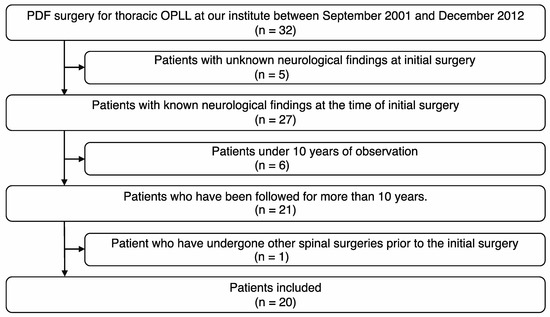
Figure 1
Open AccessArticle
Analysis of P(v-a)CO2/C(a-v)O2 Ratio and Other Perfusion Markers in a Population of 98 Pediatric Patients Undergoing Cardiac Surgery
by
, , , , , , , , , , , , and
J. Clin. Med. 2023, 12(17), 5700; https://doi.org/10.3390/jcm12175700 (registering DOI) - 01 Sep 2023
Abstract
Background: The so-called Low Cardiac Output Syndrome (LCOS) is one of the most common complications in pediatric patients with congenital heart disease undergoing corrective surgery. LCOS requires high concentrations of inotropes to support cardiac contractility and improve cardiac output, allowing for better systemic
[...] Read more.
Background: The so-called Low Cardiac Output Syndrome (LCOS) is one of the most common complications in pediatric patients with congenital heart disease undergoing corrective surgery. LCOS requires high concentrations of inotropes to support cardiac contractility and improve cardiac output, allowing for better systemic perfusion. To date, serum lactate concentrations and central venous oxygen saturation (ScVO2) are the most commonly used perfusion markers, but they are not completely reliable in identifying a state of global tissue hypoxia. The study aims to evaluate whether the venoarterial carbon dioxide difference/arterial-venous oxygen difference ratio [P(v-a)CO2/C(a-v)O2] can be a good index to predict the development of LCOS in the aforementioned patients, so as to treat it promptly. Methods: This study followed a population of 98 children undergoing corrective cardiac surgery from June 2018 to October 2020 at the Department of Cardiac Surgery of University Hospital Integrated Trust and their subsequent admission at the Postoperative Cardiothoracic Surgery Intensive Care Unit. During the study, central arterial and venous blood gas analyses were carried out before and after cardiopulmonary bypass (CPB) (pre-CPB and post-CPB), at admission to the intensive care unit, before and after extubation, and at any time of instability or modification of the patient’s clinical and therapeutic conditions. Results: The data analysis shows that 46.9% of the children developed LCOS (in line with the current literature) but that there is no statistically significant association between the P(v-a)CO2/C(a-v)O2 ratio and LCOS onset. Despite the limits of statistical significance, however, a 31% increase in the ratio emerged from the pre-CPB phase to the post-CPB phase when LCOS is present. Conclusions: This study confirms a statistically significant association between the most used markers in adult patients (serum lactate concentration, ScVO2, and oxygen extraction ratio—ERO2) measured in the pre-CPB phase and the incidence of LCOS onset, especially in patients with hemodynamic instability before surgery.
Full article
(This article belongs to the Section Cardiology)
►▼
Show Figures

Figure 1
Open AccessFeature PaperReview
Interleukin-23 Involved in Fibrotic Autoimmune Diseases: New Discoveries
by
and
J. Clin. Med. 2023, 12(17), 5699; https://doi.org/10.3390/jcm12175699 (registering DOI) - 01 Sep 2023
Abstract
Interleukin (IL)-23 is a central pro-inflammatory cytokine with a broad range of effects on immune responses. IL-23 is pathologically linked to the induction of the production of the pro-inflammatory cytokines IL-17 and IL-22, which stimulate the differentiation and proliferation of T helper type
[...] Read more.
Interleukin (IL)-23 is a central pro-inflammatory cytokine with a broad range of effects on immune responses. IL-23 is pathologically linked to the induction of the production of the pro-inflammatory cytokines IL-17 and IL-22, which stimulate the differentiation and proliferation of T helper type 17 (Th17) cells. Recent discoveries suggest a potential pro-fibrotic role for IL-23 in the development of chronic inflammatory autoimmune diseases characterized by intense fibrosis. In this review, we summarized the biological features of IL-23 and gathered recent research on the role of IL-23 in fibrotic autoimmune conditions, which could provide a theoretical basis for clinical targeting and drug development.
Full article
(This article belongs to the Special Issue Systemic Autoinflammatory Diseases—Clinical Rheumatic Challenges Series 2)
►▼
Show Figures
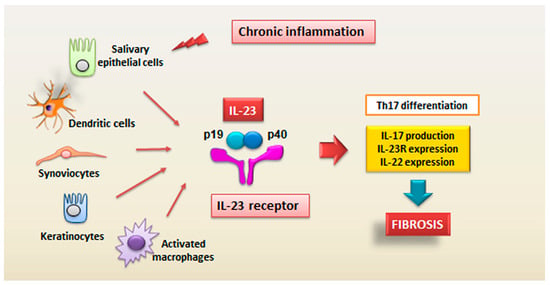
Graphical abstract
Open AccessReview
Prevalence of Incidental Findings Suspicious for Transthyretin Cardiac Amyloidosis among Patients Undergoing Bone Scintigraphy: A Systematic Review and a Meta-Analysis
by
, , , , , , , , , and
J. Clin. Med. 2023, 12(17), 5698; https://doi.org/10.3390/jcm12175698 (registering DOI) - 01 Sep 2023
Abstract
Background: The myocardial uptake of bone-seeking tracers suspicious for transthyretin cardiac amyloidosis (ATTR-CA) can be incidentally detected in patients undergoing bone scintigraphy for noncardiac reasons. We conducted a systematic review and meta-analysis to assess the prevalence of these scintigraphic findings. Methods: A comprehensive
[...] Read more.
Background: The myocardial uptake of bone-seeking tracers suspicious for transthyretin cardiac amyloidosis (ATTR-CA) can be incidentally detected in patients undergoing bone scintigraphy for noncardiac reasons. We conducted a systematic review and meta-analysis to assess the prevalence of these scintigraphic findings. Methods: A comprehensive literature search was performed using two bibliographic databases (PubMed/MEDLINE and Cochrane Library), searching for articles related to the review question. Eligible articles were selected, and relevant data were extracted by two authors. The pooled prevalence of incidental findings suspicious for ATTR-CA among patients undergoing bone scintigraphy was calculated on a per-patient-based analysis using a random-effects model. The pooled measure was provided with 95% confidence interval (95% CI) values. Results: Among 219 records, 11 articles were selected for the systematic review and 10 for the meta-analysis. The pooled prevalence of incidental findings suspicious for ATTR-CA was 1.1% (95% CI: 0.7–1.4%) with heterogeneity due to the characteristics of the included studies, patients, and index tests. These findings are more prevalent in older men. Conclusions: The prevalence of incidental findings of ATTR-CA among patients undergoing bone scintigraphy is low but not negligible. Nuclear medicine physicians should suggest, in the scintigraphic report, further clinical investigations when these findings are detected. Prospective studies are warranted.
Full article
(This article belongs to the Special Issue Advancements in Diagnosis and Management of Hypertrophic Cardiomyopathy and Amyloidosis)
►▼
Show Figures
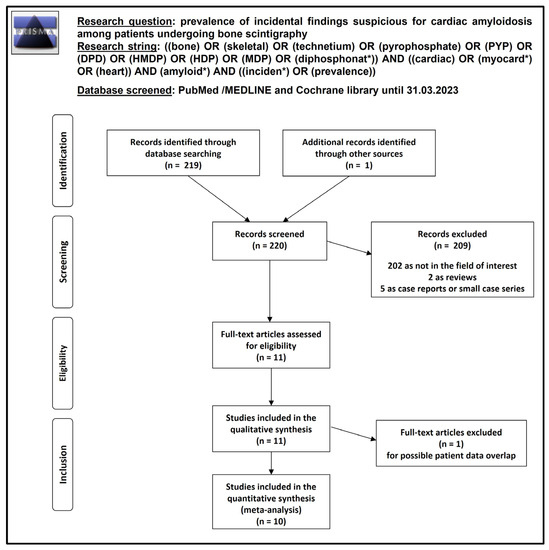
Figure 1
Open AccessReply
Reply to Schimmelbusch, K.J.; Collison, F.T. Comment on “Rosa et al. Optic Nerve Drusen Evaluation: A Comparison between Ultrasound and OCT. J. Clin. Med. 2022, 11, 3715”
by
, , , , and
J. Clin. Med. 2023, 12(17), 5697; https://doi.org/10.3390/jcm12175697 (registering DOI) - 01 Sep 2023
Abstract
We appreciate the comments of Schimmelbusch et al. [...]
Full article
(This article belongs to the Section Ophthalmology)
►▼
Show Figures
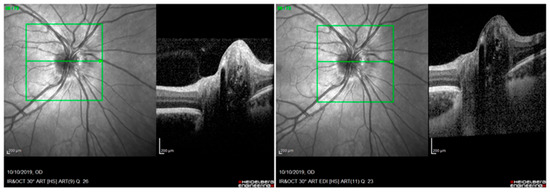
Figure 1
Open AccessArticle
The Impact of Advanced Maternal Age on Pregnancy Outcomes: A Retrospective Multicenter Study
by
, , , , , , , and
J. Clin. Med. 2023, 12(17), 5696; https://doi.org/10.3390/jcm12175696 (registering DOI) - 01 Sep 2023
Abstract
The aim of this multicenter retrospective cohort study was to examine the impact of maternal age on perinatal outcomes in multiparas, stratified according to maternal age in one- and two-year increments. The analysis involved 302,484 multiparas who delivered between the years 2003 and
[...] Read more.
The aim of this multicenter retrospective cohort study was to examine the impact of maternal age on perinatal outcomes in multiparas, stratified according to maternal age in one- and two-year increments. The analysis involved 302,484 multiparas who delivered between the years 2003 and 2021 in four university-affiliated obstetrics departments. Maternal age was considered both as a continuous variable and in two-year intervals, as compared with a comparison group of parturients aged 25–30 years. The study focused on cesarean delivery and neonatal intensive care unit (NICU) admission as primary outcomes. The findings revealed that cesarean delivery rates increased as maternal age advanced, with rates ranging from 6.7% among 25–30 year olds, rising continuously from 13.5% to 19.9% between the age strata of 31 and 42, to exceeding 20% among those aged ≥ 43 years (p < 0.01 for each stratum when compared to 25–30 year old group). Similarly, NICU admission rates rose from 2.7% in the comparison group to 6% in parturients aged 45–46 years (p < 0.01 for each stratum when compared to 25–30 year old group). The study highlights the association between incrementally advanced maternal age and increased rates of maternal and neonatal complications, necessitating global awareness of these implications for family planning decisions and maternal care.
Full article
(This article belongs to the Special Issue Current Trends in Reproductive Health Epidemiology)
►▼
Show Figures
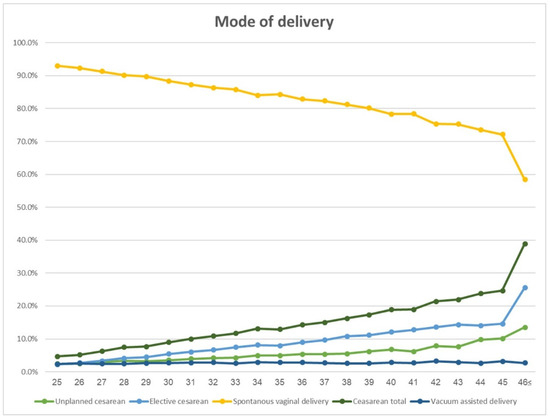
Figure 1
Open AccessArticle
Biomarkers of Collagen Metabolism Are Associated with Left Ventricular Function and Prognosis in Dilated Cardiomyopathy: A Multi-Modal Study
by
, , , , , , , , , , , and
J. Clin. Med. 2023, 12(17), 5695; https://doi.org/10.3390/jcm12175695 (registering DOI) - 01 Sep 2023
Abstract
Background: Collagen cross-linking is a fundamental process in dilated cardiomyopathy (DCM) and occurs when collagen deposition exceeds degradation, leading to impaired prognosis. This study investigated the associations of collagen-metabolism biomarkers with left ventricular function and prognosis in DCM. Methods: DCM patients who underwent
[...] Read more.
Background: Collagen cross-linking is a fundamental process in dilated cardiomyopathy (DCM) and occurs when collagen deposition exceeds degradation, leading to impaired prognosis. This study investigated the associations of collagen-metabolism biomarkers with left ventricular function and prognosis in DCM. Methods: DCM patients who underwent endomyocardial biopsy, blood sampling, and cardiac MRI were included. The primary endpoint included death, heart failure hospitalization, or life-threatening arrhythmias, with a follow-up of 6 years (5–8). Results: In total, 209 DCM patients were included (aged 54 ± 13 years, 65% male). No associations were observed between collagen volume fraction, circulating carboxy-terminal propeptide of procollagen type-I (PICP), or collagen type I carboxy-terminal telopeptide [CITP] and matrix metalloproteinase [MMP]-1 ratio and cardiac function parameters. However, CITP:MMP-1 was significantly correlated with global longitudinal strain (GLS) in the total study sample (R = −0.40, p < 0.0001; lower CITP:MMP-1 ratio was associated with impaired GLS), with even stronger correlations in patients with LVEF > 40% (R = −0.70, p < 0.0001). Forty-seven (22%) patients reached the primary endpoint. Higher MMP-1 levels were associated with a worse outcome, even after adjustment for clinical and imaging predictors (1.026, 95% CI 1.002–1.051, p = 0.037), but CITP and CITP:MMP-1 were not. Combining MMP-1 and PICP improved the goodness-of-fit (LHR36.67, p = 0.004). Conclusion: The degree of myocardial cross-linking (CITP:MMP-1) is associated with myocardial longitudinal contraction, and MMP-1 is an independent predictor of outcome in DCM patients.
Full article
(This article belongs to the Special Issue Advances in the Diagnosis and Management of Dilated Cardiomyopathy)
►▼
Show Figures
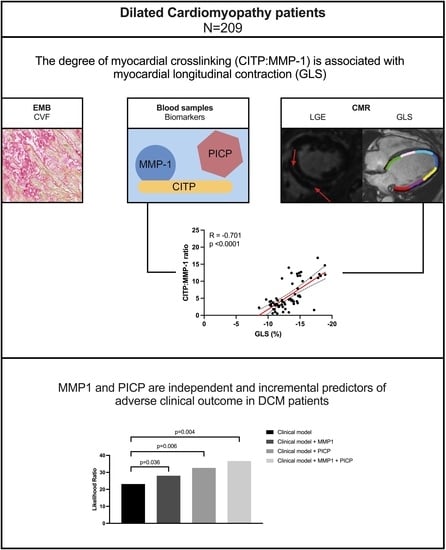
Graphical abstract
Open AccessArticle
Combined Biologic Augmentation Strategies with Collagen Patch Graft, Microfractures, and Platelet Concentrate Injections Improve Functional and Structural Outcomes of Arthroscopic Revision Rotator Cuff Repair
by
, , , , and
J. Clin. Med. 2023, 12(17), 5694; https://doi.org/10.3390/jcm12175694 (registering DOI) - 01 Sep 2023
Abstract
Background: Arthroscopic revision rotator cuff repair (ARRCR) is challenging. Biologic strategies seem to be promising. The aim was to evaluate the effectiveness of the combination of microfractures of the greater tuberosity, augmentation with collagen patch graft, and platelet concentrate injections in ARRCR. Methods:
[...] Read more.
Background: Arthroscopic revision rotator cuff repair (ARRCR) is challenging. Biologic strategies seem to be promising. The aim was to evaluate the effectiveness of the combination of microfractures of the greater tuberosity, augmentation with collagen patch graft, and platelet concentrate injections in ARRCR. Methods: A retrospective comparative study was conducted on patients that underwent ARRCR with a minimum follow-up of two years. Patients in the augmentation group underwent ARRCR combined with microfractures, collagen patch graft, and postoperative subacromial injections of platelet concentrate. A standard rotator cuff repair was performed in the control group. Primary outcome: Constant-Murley score (CMS). Secondary outcomes: disease-specific, health-related quality of life using the Disabilities of the Arm, Shoulder, and Hand (DASH) score; assessment of tendon integrity with magnetic resonance at least six months after surgery. Significance was set at p < 0.05. Results: Forty patients were included. Mean follow-up was 36.2 ± 8.7 months. The mean CMS was greater in the augmentation group (p = 0.022). No differences could be found for DASH score. Healing failure rate was higher in the control group (p = 0.002). Conclusion: Biologic augmentation of ARRCR using a combination of microfractures, collagen patch graft, and subacromial injections of platelet concentrate is an effective strategy in improving tendon healing rate. Level of evidence: retrospective cohort study, level III.
Full article
(This article belongs to the Special Issue Advances in Shoulder Surgery)
►▼
Show Figures
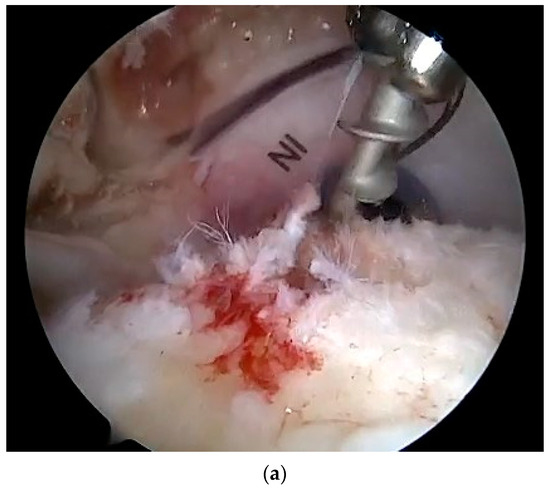
Figure 1
Open AccessReview
Hybrid Treatment of Complex Diseases of the Aortic Arch and Descending Thoracic Aorta by Frozen Elephant Trunk Technique
by
, , , , and
J. Clin. Med. 2023, 12(17), 5693; https://doi.org/10.3390/jcm12175693 (registering DOI) - 01 Sep 2023
Abstract
The surgical management of acute and chronic complex diseases involving the aortic arch and the descending thoracic aorta remains challenging. Hybrid procedures associating total open arch replacement and stent-grafting of the proximal descending aorta were developed to allow a potential single-stage treatment, promote
[...] Read more.
The surgical management of acute and chronic complex diseases involving the aortic arch and the descending thoracic aorta remains challenging. Hybrid procedures associating total open arch replacement and stent-grafting of the proximal descending aorta were developed to allow a potential single-stage treatment, promote remodeling of the downstream aorta, and facilitate a potential second-stage thoracic endovascular aortic repair by providing an ideal landing zone. While these approaches initially used various homemade combinations of available conventional prostheses and stent-grafts, the so-called frozen elephant trunk technique emerged with the development of several custom-made hybrid prostheses. The aim of this study was to review the contemporary outcomes of this technique in the management of complex aortic diseases, with a special focus on procedural planning, organ protection and monitoring, refinements in surgical techniques, and long-term follow-up.
Full article
(This article belongs to the Special Issue Open and Endovascular Management of Complex Aortic Aneurysms)
►▼
Show Figures
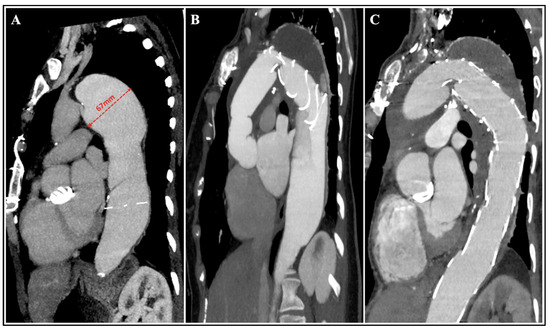
Figure 1

Journal Menu
► ▼ Journal Menu-
- JCM Home
- Aims & Scope
- Editorial Board
- Reviewer Board
- Topical Advisory Panel
- Instructions for Authors
- Special Issues
- Topics
- Sections & Collections
- Article Processing Charge
- Indexing & Archiving
- Editor’s Choice Articles
- Most Cited & Viewed
- Journal Statistics
- Journal History
- Journal Awards
- Society Collaborations
- Conferences
- Editorial Office
Journal Browser
► ▼ Journal BrowserHighly Accessed Articles
Latest Books
E-Mail Alert
News
Topics
Topic in
Cancers, Biology, Current Oncology, IJMS, JCM
Advances in Molecular and Cellular Studies in Oral Diseases
Topic Editors: Bing Liu, Ming ZhongDeadline: 20 September 2023
Topic in
Biomedicines, JCM, JPM, Reports, Toxins, Uro
Clinical, Translational, Basic Researches, and Application of Bacterial Toxins on Bladder Diseases and Lower Urinary Tract Dysfunctions
Topic Editors: Hann-Chorng Kuo, Yao-Chi Chuang, Chun-Hou LiaoDeadline: 30 September 2023
Topic in
IJERPH, JCM, Biology, Diagnostics, Dentistry Journal
Diagnosis of Craniofacial Changes: Conventional Approaches and Novel Methodologies
Topic Editors: Nikolaos Gkantidis, Carlalberta VernaDeadline: 20 October 2023
Topic in
Biomedicines, Cancers, COVID, IJERPH, JCM, Viruses
Analytics and Modelling Clinical Data Using Advanced Biostatistical Methods
Topic Editors: Jahar Bhowmik, Raaj Kishore BiswasDeadline: 31 October 2023

Conferences
Special Issues
Special Issue in
JCM
Pulmonary and Critical Care Practice in the Pandemic of COVID-19
Guest Editor: Jihad MallatDeadline: 1 September 2023
Special Issue in
JCM
Deformity Correction, Bone Lengthening and Correction Osteotomies of the Lower Limb
Guest Editor: Lukas ZakDeadline: 20 September 2023
Special Issue in
JCM
Management of Pituitary Tumors: Current and Future Treatment Options
Guest Editors: Ilan Shimon, Amit AkirovDeadline: 30 September 2023
Special Issue in
JCM
Risk Factors, Prevention and Management of Frailty in Elderly
Guest Editor: Mylene Aubertin-LeheudreDeadline: 20 October 2023
Topical Collections
Topical Collection in
JCM
Clinical Research and Advances in Hemodialysis
Collection Editors: Mariusz Kusztal, Kultigin Turkmen
Topical Collection in
JCM
Advances in Understanding the Pathogenesis and Pathophysiology of Orthopaedic-Related Infections
Collection Editor: Gerald Atkins
Topical Collection in
JCM
The Role of the Microenvironment in Multiple Myeloma: From Biology to Clinical Practice
Collection Editor: Eirini Katodritou
Topical Collection in
JCM
Clinical Diagnosis and Management of Pregnancy Complications
Collection Editor: Rinat Gabbay-Benziv




